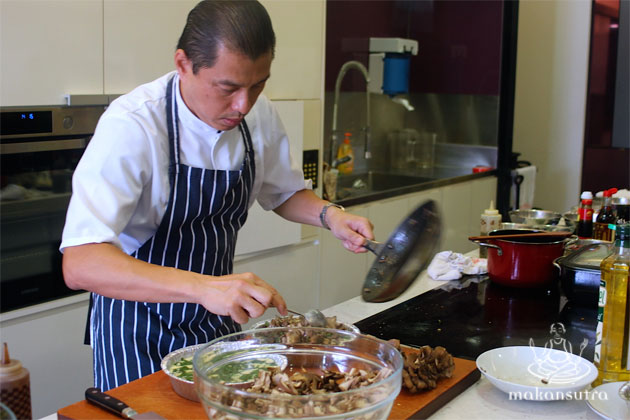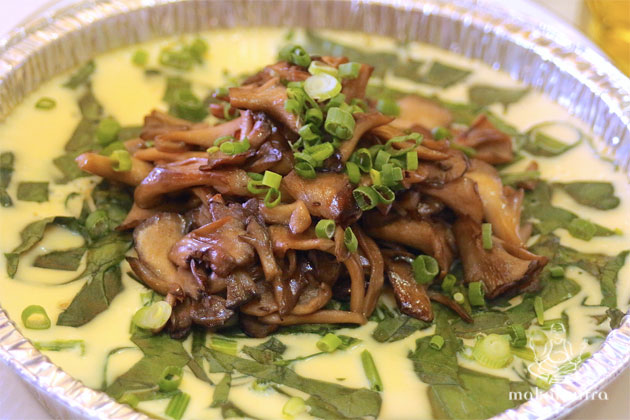
Maitake Mushroom: Once worth its weight in Gold
By Catherine Ling - Wednesday, Jul 15, 2015
Maitake (舞菇) means “dancing mushroom” in Japanese. The name came about because according to legend, it was so rare that one who found it danced with joy. Maitake has long been prized for its culinary appeal and reported medicinal qualities by the Japanese since the feudal era. In those days, Maitake was exchanged with the same weight of silver by local lords who, in turn, offered it to their boss, the Shogun.

Its English names are not so romantic – hen-of-the-woods, ram’s head or sheep’s head – but it’s still tasty nonetheless. Maitake has a pleasant, crunchy, very chewable texture all the way down the stem with a distinct woodsy smell and flavour.
This mushroom has only recently become domesticated, and Japan’s largest mushroom grower Hokuto has figured out how to grow it commercially using automated machines that ensure no hands touch it from planting to packaging. Hygiene is important given that we aren’t supposed to wash mushrooms. Hokuto’s Malaysian arm Hokto has a farm just outside KLIA, and it supplies mushrooms to Singapore supermarkets and hotels.
Like many mushrooms, maitake is low in calories, but has the highest concentration of vitamin D (about 300IU per 100g). Mycologists and medical researchers have also recognised maitake as a medicinal fungi which can help boost the immune system, aid weight loss, and treat several diseases – cancer, diabetes, high cholesterol, and hypertension.
Local celebrity chef Jimmy Chok recently gave a demo of dishes using maitake mushrooms. He had several useful tips to share.

1. Don’t wash mushrooms! This settles the debate. They will get soggy with water.
2. Buy mushrooms whole, not in pieces, and put them in the fridge immediately. Our weather is killer to produce.
3. Cut mushrooms only prior to cooking. They start wilting and losing flavour once they are cut.
4. When stir-frying mushrooms, leave them alone! Let them brown and caramelise. If you stir them too much, you will have a watery mess. The idea is to have as little liquid leech out as possible.
5. Don’t overcrowd the pan, the ingredients when tossed alternately gets hot and cold; they will literally perspire
6. Don’t cover your stir-fry. Again, this leads to a steamy, watery mess.
7. When frying, start with your mushrooms first to get flavour out of them, then add garlic, not the other way around as most Asian cooks tend to do.
8. When whisking an egg mixture for steaming, don’t whisk too hard, or you will introduce air bubbles.
9. Want extra smooth steamed egg? Sieve it twice.
10. Some chefs actually dehydrate mushrooms to grind to powder. They crust beef and chicken with it before frying, and this ups the umami factor.
Home Made Maitake Mushroom Tofu
Serving size : 2-3 pax
Preparation time : 25 minutes

Ingredients:
300 ml Unsweetened soy bean milk
3 Eggs
1/2 tsp Salt
1/2 tbsp Corn flour
50 g Spinach
For the topping:
150 g Hokto Maitake Mushroom
3 pips Garlic, chopped
1/2 cup Water
1 tsp Light soy sauce
1/2 tsp Sesame oil
1/4 tsp Salt
1 tsp Corn flour ( mix with 1 tbsp water)
1 tbsp Cooking oil
A dash White pepper
20 g Spring onions, sliced
Method:
1. Remove the maitake mushroom from packaging and cut off bottom stem.
2. Mix unsweetened soy bean milk with eggs, salt and corn flour.
3. Sieve egg mixture into a medium size bowl and top with spinach.
4. Steam tofu in a steamer for 15-20 minutes or until firm.
5. In a separate frying pan, add cooking oil, maitake mushroom and garlic.
6. Next add in water, light soy sauce, sesame oil, salt and pepper. Thicken gravy with corn flour.
7. Put cooked maitake mushrooms on top of the tofu. Garnish with spring onions.
Hokto maitake mushrooms are available at NTUC Fair Price supermarkets. Chef Jimmy Chok will be conducting cooking demonstration and product sampling activity at NTUC Jem on 11th July 2015, 11.30am-1.30pm.


